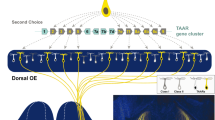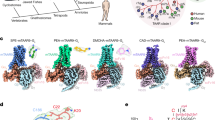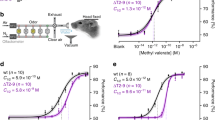Abstract
Olfaction is the primary sense used by most animals to perceive the external world. The mouse olfactory system is composed of several sensory structures, the largest of which is the main olfactory epithelium (MOE). Olfactory sensory neurons (OSNs) located within the MOE detect odors and pheromones using dedicated seven-transmembrane G protein-coupled receptors (GPCRs). Two families of GPCRs are expressed in the MOE and are conserved in humans and other vertebrates: odorant receptors (ORs) and trace amine-associated receptors (TAARs). TAARs are distantly related to biogenic amine receptors, such as dopamine and serotonin receptors. Several TAARs detect volatile amines including ethological odors that evoke innate animal behavioral responses. Mouse TAAR4 recognizes the aversive predator odor 2-phenylethylamine, while mouse TAAR5 detects the attractive male mouse odor trimethylamine. In zebrafish, TAAR13c detects the foul death-associated odor cadaverine that mediates innate avoidance behavior. TAARs thus provide an excellent model subsystem to study odor valence. And identification of additional high-affinity ligands for TAARs will provide extra tools for such study. Therefore, this chapter focuses on the so-called SEAP assay that has been successfully applied for TAAR deorphanization in different species.
Access this chapter
Tax calculation will be finalised at checkout
Purchases are for personal use only
Similar content being viewed by others
References
Liberles SD (2015) Trace amine-associated receptors: ligands, neural circuits, and behaviors. Curr Opin Neurobiol 34C:1–7. https://doi.org/10.1016/j.conb.2015.01.001
Horowitz LF, Saraiva LR, Kuang D, Yoon KH, Buck LB (2014) Olfactory receptor patterning in a higher primate. J Neurosci 34(37):12241–12252. https://doi.org/10.1523/JNEUROSCI.1779-14.2014
Hussain A, Saraiva LR, Korsching SI (2009) Positive Darwinian selection and the birth of an olfactory receptor clade in teleosts. Proc Natl Acad Sci U S A 106(11):4313–4318. https://doi.org/10.1073/pnas.0803229106
Liberles SD, Buck LB (2006) A second class of chemosensory receptors in the olfactory epithelium. Nature 442(7103):645–650. https://doi.org/10.1038/nature05066
Borowsky B, Adham N, Jones KA, Raddatz R, Artymyshyn R, Ogozalek KL, Durkin MM, Lakhlani PP, Bonini JA, Pathirana S, Boyle N, Pu X, Kouranova E, Lichtblau H, Ochoa FY, Branchek TA, Gerald C (2001) Trace amines: identification of a family of mammalian G protein-coupled receptors. Proc Natl Acad Sci U S A 98(16):8966–8971. https://doi.org/10.1073/pnas.151105198
Bunzow JR, Sonders MS, Arttamangkul S, Harrison LM, Zhang G, Quigley DI, Darland T, Suchland KL, Pasumamula S, Kennedy JL, Olson SB, Magenis RE, Amara SG, Grandy DK (2001) Amphetamine, 3,4-methylenedioxymethamphetamine, lysergic acid diethylamide, and metabolites of the catecholamine neurotransmitters are agonists of a rat trace amine receptor. Mol Pharmacol 60(6):1181–1188
Ferrero DM, Lemon JK, Fluegge D, Pashkovski SL, Korzan WJ, Datta SR, Spehr M, Fendt M, Liberles SD (2011) Detection and avoidance of a carnivore odor by prey. Proc Natl Acad Sci U S A 108:11235. https://doi.org/10.1073/pnas.1103317108
Ferrero DM, Wacker D, Roque MA, Baldwin MW, Stevens RC, Liberles SD (2012) Agonists for 13 trace amine-associated receptors provide insight into the molecular basis of odor selectivity. ACS Chem Biol 7:1184. https://doi.org/10.1021/cb300111e
Li Q, Korzan WJ, Ferrero DM, Chang RB, Roy DS, Buchi M, Lemon JK, Kaur AW, Stowers L, Fendt M, Liberles SD (2013) Synchronous evolution of an odor biosynthesis pathway and behavioral response. Curr Biol 23(1):11–20. https://doi.org/10.1016/j.cub.2012.10.047
Li Q, Tachie-Baffour Y, Liu Z, Baldwin MW, Kruse AC, Liberles SD (2015) Non-classical amine recognition evolved in a large clade of olfactory receptors. eLife 4. https://doi.org/10.7554/eLife.10441
Wallrabenstein I, Kuklan J, Weber L, Zborala S, Werner M, Altmuller J, Becker C, Schmidt A, Hatt H, Hummel T, Gisselmann G (2013) Human trace amine-associated receptor TAAR5 can be activated by Trimethylamine. PLoS One 8(2):e54950. https://doi.org/10.1371/journal.pone.0054950
Saraiva LR, Kondoh K, Ye X, Yoon KH, Hernandez M, Buck LB (2016) Combinatorial effects of odorants on mouse behavior. Proc Natl Acad Sci U S A 113:E3300. https://doi.org/10.1073/pnas.1605973113
Pacifico R, Dewan A, Cawley D, Guo C, Bozza T (2012) An olfactory subsystem that mediates high-sensitivity detection of volatile amines. Cell Rep 2(1):76–88. https://doi.org/10.1016/j.celrep.2012.06.006
Zhang J, Pacifico R, Cawley D, Feinstein P, Bozza T (2013) Ultrasensitive detection of amines by a trace amine-associated receptor. J Neurosci 33(7):3228–3239. https://doi.org/10.1523/JNEUROSCI.4299-12.2013
Dewan A, Pacifico R, Zhan R, Rinberg D, Bozza T (2013) Non-redundant coding of aversive odours in the main olfactory pathway. Nature 497:486. https://doi.org/10.1038/nature12114
Hussain A, Saraiva LR, Ferrero DM, Ahuja G, Krishna VS, Liberles SD, Korsching SI (2013) High-affinity olfactory receptor for the death-associated odor cadaverine. Proc Natl Acad Sci U S A 110(48):19579–19584. https://doi.org/10.1073/pnas.1318596110
Dolphin CT, Janmohamed A, Smith RL, Shephard EA, Phillips IR (1997) Missense mutation in flavin-containing mono-oxygenase 3 gene, FMO3, underlies fish-odour syndrome. Nat Genet 17(4):491–494. https://doi.org/10.1038/ng1297-491
Durocher Y, Perret S, Thibaudeau E, Gaumond MH, Kamen A, Stocco R, Abramovitz M (2000) A reporter gene assay for high-throughput screening of G-protein-coupled receptors stably or transiently expressed in HEK293 EBNA cells grown in suspension culture. Anal Biochem 284(2):316–326. https://doi.org/10.1006/abio.2000.4698
Saito H, Kubota M, Roberts RW, Chi Q, Matsunami H (2004) RTP family members induce functional expression of mammalian odorant receptors. Cell 119(5):679–691. https://doi.org/10.1016/j.cell.2004.11.021
Zhuang H, Matsunami H (2007) Synergism of accessory factors in functional expression of mammalian odorant receptors. J Biol Chem 282(20):15284–15293. https://doi.org/10.1074/jbc.M700386200
Acknowledgment
This work was supported by National Natural Science Foundation of China (to Q.L., award number 31771154), Shanghai Pujiang Program (to Q.L., award number 17PJ1405400), and Fundamental Research Funds for the Central Universities (Shanghai Jiao Tong University, to Q.L., award number 17X100040037).
Author information
Authors and Affiliations
Corresponding author
Editor information
Editors and Affiliations
Rights and permissions
Copyright information
© 2018 Springer Science+Business Media, LLC, part of Springer Nature
About this protocol
Cite this protocol
Li, Q. (2018). Deorphanization of Olfactory Trace Amine-Associated Receptors. In: Simoes de Souza, F., Antunes, G. (eds) Olfactory Receptors. Methods in Molecular Biology, vol 1820. Humana Press, New York, NY. https://doi.org/10.1007/978-1-4939-8609-5_2
Download citation
DOI: https://doi.org/10.1007/978-1-4939-8609-5_2
Published:
Publisher Name: Humana Press, New York, NY
Print ISBN: 978-1-4939-8608-8
Online ISBN: 978-1-4939-8609-5
eBook Packages: Springer Protocols




